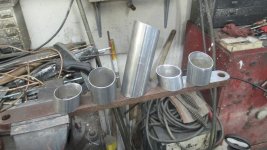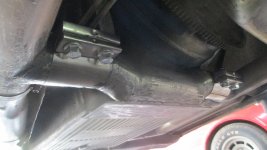toobroketoretire
Banned
A couple of weeks ago I decided to fabricate and install an h-pipe on my big block '71 to quiet the exhaust noise down a bit. Dual exhaust is certainly better than a single exhaust for larger engines operating at higher rpm's but the uneven firing impulses of our American V8's still present a problem. You see, our V8 engines have their troublesome 8/4 and 5/7 cylinders firing only 90 degrees apart and the slug of exhaust gas from the first cylinder to fire interferes with the slug of exhaust gas from the cylinder after it. By installing an h-pipe some of the pressure from the first cylinder is bled off into the other exhaust pipe so the next cylinder's exhaust blows out a bit easier. Because the pressures are highest AT the engine the best place to install an h-pipe is as close to the engine as possible. As I'm not running the noise reduction cover under my torque converter (aka dust cover) I chose to install my h-pipe right behind my torque converter where it would do the most good. After the installation my exhaust was about 25% quieter and it appears I gained a tiny bit of power and fuel mileage. To be able to clear the bottom of my torque converter I designed my h-pipe using 5 angle-cut pieces to achieve a 3/4" dropped center which gave it about 3/8" of clearance.







